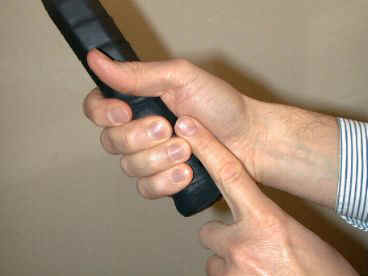Tennis elbow, rowing elbow, or lateral epicondylitis to give it itís medical
name (meaning inflammation of the outer part of the elbow), is a fairly common
condition affecting about four adults per thousand annually.Symptoms include
pain over the outer side of the elbow which may be worse on gripping or lifting
any object such as a kettle or racquet handle.
The cause of tennis elbow is usually, but not always, obvious and as well as
racquet sports include using a screwdriver, painting and even lifting and
carrying suitcases.
In preventing the condition, particular attention should be paid to equipment
and coaching or training. Prolonged use of a heavy racquet may cause problems
and if the racquet handle is too big or too small, extra effort has to be put
into gripping and this may affect stroke play. When buying a new racquet
ideally discuss this with a coach beforehand or talk to someone in the shop who
really knows about it. You need to consider grip size see below,
balance and weight of the racquet, size of the racquet and, nowadays with modern
tennis racquets, their degree of flexibility. If in doubt about the size of the
grip that you require, buy one that is slightly too small because it is always
possible to build the grip size up.
Once you start to get symptoms, try not to ignore it. Rest, particularly
early on, may cause the pain to resolve but you should also consider taking
advice from a tennis coach and/or sports physiotherapist. If the condition is
not resolving you may need to seek medical advice. The options for treatment
would then include taking
non
steroidal anti inflammatories, such as Ibuprofen, or a steroid injection
into the elbow. Both of these options should be accompanied by rest.
One should always bear in mind that medical intervention may cause problems
or side effects, for example an injection will be painful at the time and for a
few days afterwards. There is always a risk of introducing infection and the
steroid may cause damage to the overlying skin. Non steroidal anti inflammatory
drugs also have potential side effects.
Remember, prevention is better than cure and if you do start to experience
symptoms, early rest and seeking advice from an expert may help the problem
resolve rapidly.
Grip Size
 Holding
an eastern forehand grip (the palm is placed against the same bevel as the
string face), you should be able to fit the index finger of your non-hitting
hand in the space between your ring finger and palm. If there isn't enough room
for your index finger, the grip is too small. If there is space between your
finger and palm, the grip is too big. A too-small grip requires more muscle
strength to keep the racquet from twisting in your hand. Prolonged use of
a grip that's too small can contribute to tennis elbow problems. A grip that's
too large inhibits wrist snap on serves, makes changing grips more difficult and
also requires more muscle strength. Prolonged use of a grip that's too big can
also contribute to tennis elbow problems.
Holding
an eastern forehand grip (the palm is placed against the same bevel as the
string face), you should be able to fit the index finger of your non-hitting
hand in the space between your ring finger and palm. If there isn't enough room
for your index finger, the grip is too small. If there is space between your
finger and palm, the grip is too big. A too-small grip requires more muscle
strength to keep the racquet from twisting in your hand. Prolonged use of
a grip that's too small can contribute to tennis elbow problems. A grip that's
too large inhibits wrist snap on serves, makes changing grips more difficult and
also requires more muscle strength. Prolonged use of a grip that's too big can
also contribute to tennis elbow problems.
